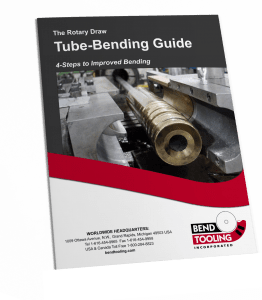Today’s blog dives into the world of low-pressure tube bending. This technique helps you achieve clean, precise bends without putting unnecessary stress on your materials, tooling and bender.
Although many benders have the ability to generate a tremendous amount of force, specifically with direct pressure-die pressure, it’s important to use only what is required – anything more is counterproductive.
Key Components: Mandrel and Pressure Die
Two key components make low-pressure bending possible:
- The Mandrel: This internal support tool fits inside the tube to prevent the tube from kinking, wrinkles from forming and the wall from collapsing. The further you insert the mandrel past tangency, the less pressure you’ll need from….
- The Pressure Die: This external clamp holds the tube firmly against the bend die throughout the bending process. But here’s the catch: we want the pressure die to be like a friendly hug, not a suffocating squeeze.
Anticipating Pressure
There’s no one-size-fits-all pressure setting. It depends on your:
- Tube Material: Soft metals like aluminum or copper require less pressure than tougher ones like steel, stainless steel or titanium.
- Tube Shape: Round tubes generally need less pressure compared to square or rectangular tubes
- Wall Thickness: Although heavy-walled tubes can handle more pressure before deforming, they generally don’t require much more pressure than thin-walled tubes.
- Bend Radius: Tighter bend radii experience more elongation along the outside of the bend and more compression along the inside of the bend than larger bend radii, so more pressure will be expected with tighter radius applications.
Setting the Mandrel and Pressure-die:
Assuming all relevant tooling components are installed for your application, lets pay close attention to the:
- Mandrel position: For clearance purposes, the mandrel is slightly smaller than the inside diameter of the tube and often has a radius at the leading edge of the nose. This means the mandrel may be positioned past tangent to a position where the tube is drawn over its leading edge.
- Pressure-die pressure: Adjust the pressure-die to the anticipated pressure settings. The primary goal is the keep the back end of the tube from pushing away from the bend die, if a wiper die is being used, the secondary objective is to keep enough pressure on the tube to prevent wrinkles.
Fine-Tuning Your Bends
Tweaking the set-up for perfect results!
- Pressure-die tracking: verify the pressure-die is maintaining constant position against the bend die. If it is pushing away from the bend-die during the bending process then you must increase pressure.
- Inner Wrinkles: If the inside of your bend is wrinkled, move the mandrel deeper into the bend. If the problem persists, you may also need to increase pressure-die pressure.
- Outer Collapse: If the outside of the bend exhibits outlines of the mandrel balls or is collapsing, it’s getting squeezed too much. Reduce pressure-die pressure slightly and see if that fixes the issue.
Remember: It’s always better to start with low pressure and gradually increase it if needed. This way, you minimize the risk of damaging your bender and tooling.

